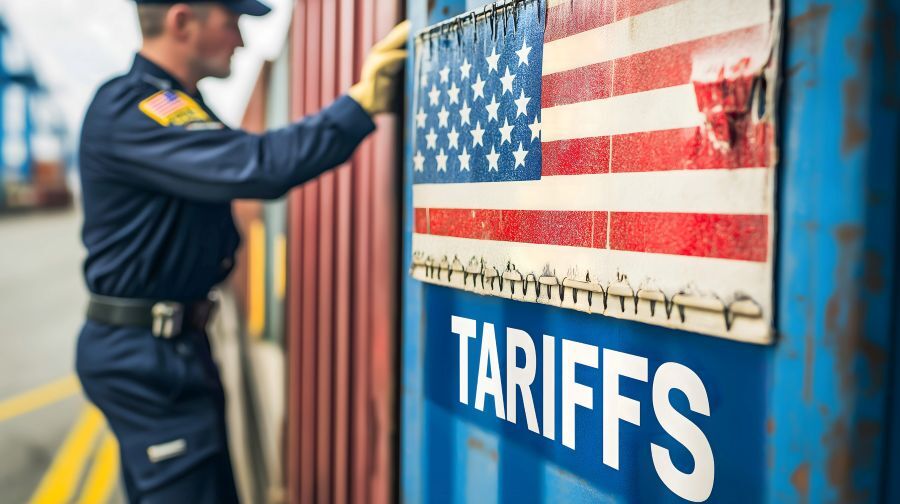What Supply Chain Professionals Need to Know About Tariffs

If you have ever wondered why the same product costs a lot more in one country compared to another or the reason some products suddenly become expensive or cheap after a government decision?
The answer almost always boils down to tariffs.
With much news coming in from the U.S. lately, you have likely heard about tariffs a lot recently.
Tariffs might look like an abstract economic idea and hard to understand, but they are quite simple. And they matter a lot whether you own a business or if you work in supply chain and logistics.
This article helps understand tariffs, discusses their mechanism, and explains why they are essential for global trade and supply chains.
Let's start by understanding what a tariff is.
What Is a Tariff?
A tariff is a tax a government levies on imported (or sometimes exported) goods. The most common tariff is an import tariff, which is levied when you buy and import products produced in a foreign country.
Let's understand this better with an example.
Suppose the United States imports steel from China.
If the United States decides to impose a 25% tariff on Chinese steel, the company that imports Chinese steel into the U.S. must pay an additional 25% on the value of the import.
That cost is often passed on to the next business in the chain or to the consumer.
There are a few types of tariffs:
-
Ad valorem tariffs: are the most common type of tariff. They are based on a percentage of the value of the goods. For example, a 10% tariff on $1,000 worth of goods equals $100.
-
Specific tariffs: These are fixed amounts charged per unit, like $2 per pair of shoes.
-
Compound tariffs: A mix of the two above. For example, 5% of the value plus $1 per unit.
Now that we understand tariffs, let's discuss why governments impose them in the first place.
Why Do Governments Use Tariffs?
The reasons for using tariffs differ from country to country, but usually, the main reasons that the governments use the tariffs are:
1. Protect Domestic Industries
Tariffs make imported goods more expensive, giving local companies a better chance of competing and growing. For example, if cheap foreign steel floods the market, a tariff can level the playing field for U.S.-based steel makers.
2. Generate Revenue
In some countries, tariffs are a major source of government income, especially where income taxes aren't widely collected.
3. Retaliate or Negotiate
Tariffs can also be used in trade disputes. If Country A thinks Country B is playing unfairly, it might impose import tariffs to retaliate or negotiate better terms. This is what Trump and the United States have been doing lately.
With the right intention, tariffs can boost domestic industry and help it flourish. They can safeguard the national interest and also bring in additional revenue streams for the government.
Next, let's understand the impact of the tariff on the markets and supply chains.
How Tariffs Affect Prices and Availability
Tariffs can impact everyone in the supply chain, from manufacturers to consumers. Here's how:
End Customer Pays Higher Prices
When tariffs are imposed, importers have to pay more. Those costs usually flow downstream in the supply chain, resulting in more expensive products for the end customers, such as cars, electronics, and food.
For example, in 2018 and 2019, the Peterson Institute for International Economics estimated that U.S. households spent $ 800 more yearly on additional costs when the United States tariffed Chinese goods.
Product Availability can Drop
Some companies may stop importing certain goods because tariffs make them too expensive and unviable to trade. After all, similar or better alternatives are available at competitive prices domestically. That means fewer choices or delays in getting products.
Shifts in Sourcing for the Importers
Companies often change suppliers to avoid high tariffs. For instance, a U.S. firm facing a 25 percentage points increase in tariff on Chinese components might start buying from Mexico, India, or Vietnam.
So, it is clear that tariff changes affect end customers and businesses. Next, let's understand their impact on Supply Chains.
The Supply Chain Domino Effect
Tariffs affect more than one company, they create ripple effects across entire supply chains. Let's analyze this further.
1. Raw Materials Can Impact the Finished Goods Prices
Tariffs on raw materials like aluminum or lumber increase manufacturers' costs, affecting the price of finished products and making them costlier for end customers.
2. Few Components Can Derail the Production
If you're assembling a smartphone in the U.S., and you import chips from Taiwan, screens from South Korea, and batteries from China — a tariff on any of those parts can disrupt your whole process.
3. Finished Goods Getting More Expensive
Tariffs can directly affect retailers importing finished products (like furniture or clothing), forcing them to raise prices or find new suppliers.
4. The unseen impact on Freight and Logistics
Higher costs and sourcing changes affect freight volumes, transportation routes, and warehouse planning. With the increase in tariffs on Chinese products, there are now discussions on how those products can be rerouted via Europe to optimize tariffs.
How Tariffs Influence Supply Chain Decisions
So, it's clear that one change in the tariffs can create a domino effect in the supply chain. Supply chain leaders must constantly respond to tariffs. Here's how they can adapt:
Focus on Supplier Diversification
Companies source from multiple regions rather than relying on one country to reduce risk.
Try Nearshoring or Reshoring
Bringing production closer to home, or back to the home country, can avoid tariffs and reduce dependency on overseas suppliers.
Create Right Inventory Strategies
Tariffs may lead businesses to build up inventory in advance to avoid price hikes. Or, they may reduce inventory to stay flexible in changing tariff conditions.
Legal and Compliance Adjustments
Tariffs mean new paperwork, changing HS codes, and staying updated with trade laws. Compliance teams need to be on their toes.
Tariffs and Small Businesses
It’s not just the big players that feel the impact. Small and medium-sized businesses are often hit harder by tariffs:
- They have less bargaining power with suppliers.
- They may not have the resources to switch suppliers or absorb extra costs.
- They face delays if they don't fully understand new customs processes.
For example, a small outdoor gear company in the U.S. that imports backpacks from China might see its profit margins shrink overnight if a 15% tariff is suddenly applied.
How C3 Solutions Helps Supply Chains Manage the Tariff Challenges
Tariffs can change how companies buy, sell, and ship products worldwide. Whether you are a global company or a local distributor, knowing tariffs and how to prepare for them is crucial for building a strong supply chain.
Tariffs can increase costs, impact routes, and even cause delays. But with the right strategies, tools, and partners like C3 Solutions, companies can overcome these challenges and become stronger.
At C3 Solutions, we understand that fluctuating tariffs can throw your operations off balance. We can't change government policy, but we can give you the tools to stay agile, reduce delays, and cut through the noise.
Our yard and dock management systems help you:
- Stay flexible when switching suppliers or routes due to tariffs
- Improve scheduling and reduce idle time at docks
- Keep a tight grip on inventory flow, especially when inbound shipments change due to tariffs
- Increase visibility across your facilities, so you're not caught off guard by late deliveries or overbooked yards
Are you prepared to protect your supply chain from global disruptions such as tariffs? Contact C3 Solutions to learn how smarter yard and dock management can keep your business moving, no matter what happens.



